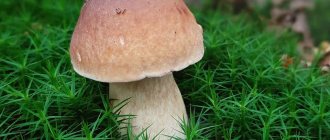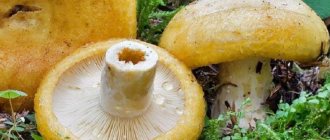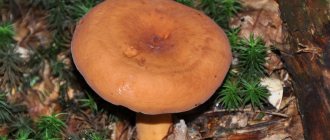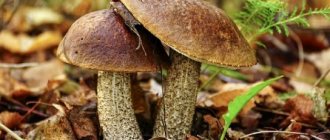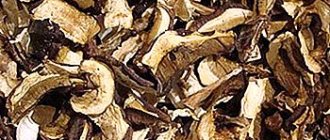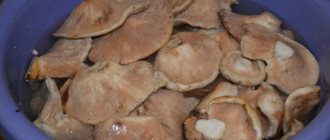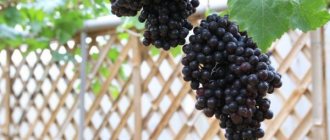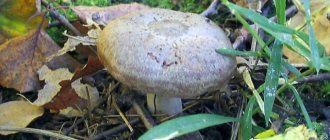Black milk mushroom, which is called nigella, is highly prized by lovers of quiet hunting. Not only does this forest dweller have excellent taste, but it is also rich in nutrients.
What adds to its popularity is the ability to harvest for quite a long time. The season starts in August and ends in November. Despite a number of stereotypes indicating that this mushroom is not edible, experts have long noted this myth. In the countries of the former USSR, this particular variety is regularly included in the TOP most collected.
This is explained by the fact that people know exactly how to prepare the harvest. Moreover, in most cases, preparation involves winter preparations with canning.
Description
Black milk mushroom (Lactarius necator) is a conditionally edible mushroom that has a low stem and a marsh-black cap with a small depression in the middle. It doesn’t look very attractive, but experienced mushroom pickers advise not to pass by such a forest “delicacy”. Some even compare nigella (this is the second name of the mushroom) with truffle on the taste scale.
Did you know? Mushrooms are the largest group of living things on the planet! Each species has its own hierarchy and laws of habitat.
The mushroom can be easily recognized in the forest by its external description, despite its rather unremarkable appearance:
- cap diameter: from 7 to 20 cm;
- leg height: from 3 to 8 cm;
- white pulp;
- texture is dense, non-porous;
- the skin of the cap is sticky and slippery;
- the color of the cap is olive, brown or brown with black spots;
- the average weight of one mushroom is 30–50 g.
The milk mushroom belongs to the Russula family and belongs to the Milky genus. Its habitat is birch groves, as well as mixed forests with a lot of moss. It grows in large groups on a mossy litter, in places where there is a large amount of light, sometimes under trees.
How to distinguish a black milk mushroom from a false milk mushroom and from a pig mushroom
Unfortunately, the black milk mushroom is very easy to confuse with its poisonous counterparts - the false milk mushroom and the sour mushroom, which in recent years have increasingly become classified as poisonous mushrooms due to their ability to accumulate heavy metals.
Rules
Harmful substances were discovered in the pig, which, when entering the human body, lead to a significant decrease in red blood cells in the blood, which can provoke severe intoxication, even death. The danger is that manifestations of poisoning may not occur immediately, but several hours and sometimes years after eating the mushroom!
IMPORTANT! Be careful when picking mushrooms! In recent years, there has been a trend towards mimicry of poisonous mushroom species, which are becoming more and more similar in appearance to edible mushrooms. And such cases of poisoning with “familiar mushrooms” are becoming more and more frequent!
You need to know a few simple nuances in order to be able to distinguish black milk mushrooms from poisonous “imitators”:
- Black milk mushroom usually always grows straight.
- The downward plates of the black milk mushroom are evenly attached to its leg
- The milk mushroom plates are always light
Appearance of the pig
Now let's look in more detail at the differences between black milk mushrooms and svinushka and false ones.
In the forest, black milk mushrooms often grow next to pig mushrooms and can confuse an inexperienced mushroom picker. If you examine both mushrooms in detail, you can note that the svinushka has a larger cap, up to twenty centimeters in diameter, versus an average of no more than fifteen centimeters of the cap of the milk mushroom. The shape and shades of the pig's cap are also slightly different - the cap is first convex and then flat, with the edge turned inward. The color is yellow-brown, sometimes with an admixture of olive. The flesh of the mushroom is light brown, darkens when cut. The plates can be easily removed from the cap. The leg is up to nine centimeters, the same color as the cap, and, as a rule, is shifted to the side and narrowed downwards.
The difference between black milk mushroom and its false and poisonous counterpart
The cap is from four to twelve centimeters in diameter, dense and fleshy, sometimes with a tubercle that is first folded along the edge and then droops. The older the false mushroom, the more “naked” its cap is. The color ranges from purplish-reddish to dirty pink with a gray or brown tint. The plates are narrow, whitish, becoming beige-pink or orange-ocher with age. The stem is dense and becomes hollow over time. The flesh of the false mushroom is yellowish with a reddish tint.
Other names for black milk mushroom
Common names for black milk mushroom:
- blackie (due to the color of the spots on the hat);
- spruce mushroom (this name appeared as a designation of the place of cultivation - coniferous forests, mixed forests);
- black hollow (associated with a depression on the surface);
- gypsies (also because of the color);
- the mushroom has as many as eight Latin names assigned to it by mycologists and botanists such as Jean Baptiste François Pierre Bulliard, Elias Magnus Fries, Otto Kunze and Samuel Frederick Gray.
Important! The best time to collect is early morning. The sun and dew make the mushroom cap shine, and it is easier to find it in dense grass.
The use of milk mushrooms in folk medicine
Black milk mushrooms are not used in official medicine. But the experience of traditional healers says that blackberries have a slight sedative effect (due to B vitamins), so they are useful for people suffering from sudden mood swings and depression. The vitamin and mineral composition of milk mushrooms has a beneficial effect on the condition of hair, nails, and skin.
It is also believed that black milk mushroom is good for stimulating immunity and metabolism, treating exhaustion, preventing liver disease and kidney stones.
Edible or not?
Today this type of mushroom is not recommended for consumption. Recent studies show that black milk mushrooms contain a substance such as nekatorin. This is a plant mutagen, which, accumulating in tissues, harms the human body. On the other hand, some researchers deny the harm of milk mushrooms.
To destroy toxins or neutralize them, the product is usually first boiled in strongly salted water, and then pickled or prepared with soaked milk mushrooms . It is rarely eaten fried. After heat treatment, the mushroom acquires a rich purple color.
Dishes from black milk mushrooms
Preparing black milk mushrooms before salting
Black milk mushrooms are very tasty and there are many recipes for preparing them. However, they all take a very long time. And you need to start with the mandatory preparatory activities.
Mushrooms must be washed very thoroughly, as they usually contain a lot of soil and sand, which can significantly spoil the taste of any dish.
It is better to cut large mushrooms into several parts, so that with prolonged soaking the bitterness can be completely eliminated. Small mushrooms do not need to be cut.
Milk mushrooms contain milky juice, so they should be soaked in lightly salted water for three days. The water needs to be changed every six to seven hours. Any container for soaking is suitable, except galvanized and aluminum. The container with mushrooms should be kept in a cool place.
Salting black milk mushrooms cold and hot
There are two main ways to pickle black milk mushrooms: cold and hot.
- Cold salting is a long-term procedure, but cooks resort to it more often, since it is believed that the taste of milk mushrooms when cold-salted is more unique and resinous.
- Hot pickling is much easier and less time consuming, but the taste of the mushrooms is not as bright.
Let's look at each of these recipes for cooking black milk mushrooms in more detail.
Cold pickling
We will need per 1 liter:
- – black milk mushrooms 1.5 kg;
- – rock salt – 3-4 tbsp. l.;
- – currant or cherry leaf – 5-6 pcs.;
- – horseradish leaf – 5 pcs.;
- – bay leaf – 5-6 pcs.;
- – dill, umbrellas/dry – 4-6 pcs./3-4 tsp;
- – garlic – 2-3 cloves;
- – black pepper – 1-2 tsp;
- – black pepper, sweet peas – 4-6 pcs.
Initially, milk mushrooms must be prepared for salting as described above in the article. After three days we get the mushrooms. Each milk mushroom is rubbed with salt and placed in layers in a pan, alternating with sliced horseradish and garlic. The laid out layers are covered with gauze, currant or cherry leaves and horseradish leaves are laid on top. I install the oppression and keep it in a cool place for a month. It is important to ensure that the milk mushrooms do not become moldy and to regularly add brine. A month later, the mushrooms are rolled into sterilized jars.
Hot salting - a minimum of time and effort
Ingredients for pickling per 1 liter:
- – black milk mushrooms 1.5 kg;
- – rock salt – 3-4 tbsp. l.;
- – currant or cherry leaf – 5-6 pcs.;
- – horseradish leaf – 5 pcs.;
- – bay leaf – 5-6 pcs.;
- – dill, umbrellas/dry – 4-6 pcs./3-4 tsp;
- – garlic – 2-3 cloves;
- – black pepper – 1-2 tsp;
- – black pepper, sweet peas – 4-6 pcs.
Soak the mushrooms for at least three days. Let's get it. Place in a saucepan, add water so that the mushrooms float freely and cook over medium heat. Once it boils, wait 20-30 minutes.
In another pan, prepare the brine. Mix 1 liter of water, 2 tbsp. salt and put on fire. After it boils, add all the other spices except garlic.
Transfer the boiled mushrooms from the first pan into boiling brine. Cook for 30 minutes. Turn off and let cool. Then add the garlic, mix and put it in a cool place under a load for 10-15 days. After two weeks, our salted crispy milk mushrooms are absolutely ready to eat.
Marinating black milk mushrooms
The most popular pickling method is marinating in brine with garlic, vinegar, pepper and bay leaf; some cooks also add cloves.
The process is simple:
- Soak the mushrooms for at least three days. Transfer to a saucepan and bring to a boil over heat. The milk mushrooms should boil for at least 10 minutes. During the cooking process, you need to regularly remove the foam from the mushrooms. After 10 minutes, put it back in the city and rinse under running water.
- Prepare the brine for 1 kg of milk mushrooms. Mix the ingredients (1 liter of water, 2 tablespoons of salt, bay leaf, horseradish, pepper), bring to a boil and cook for 15 minutes.
- Place garlic, dill, currant leaves on the bottom of sterilized jars, then loosely place mushrooms on top, fill with marinade and add 1 tsp. 9% vinegar per 1 jar.
- Close the lids, cover with a warm blanket and let cool completely. It is better to store pickled black milk mushrooms in a cool, dark place.
Fried black milk mushrooms
How to properly fry a delicacy mushroom?
Frying black milk mushrooms is not as popular as salting them, but also has a right to exist. For this method of preparing black milk mushrooms, it is best to use only the caps.
Soak the mushrooms for three days. Boil in boiling water twice for 5 minutes, changing the water each time.
Place the mushrooms in a colander and let them cool and drain off excess water. Then finely chop and simmer covered in a frying pan without adding oil for 10 minutes.
The juice that was released during the stewing process must be drained, add vegetable oil, garlic and parsley to the pan and fry the milk mushrooms until golden brown.
Bon appetit!
Taste qualities
If you cook milk mushrooms correctly, it will look like a delicious dish, the like of which cannot be found among homemade preparations. Due to the dense pulp, this product saturates very quickly. Has a subtle mushroom smell. The surface of salted or soaked milk mushrooms is smooth and slimy. It is practically not eaten when fried or raw.
The taste is generally neutral, but it is quite possible to enhance it by adding garlic or other herbs and spices. When salted, it is served drizzled with butter and seasoned with herbs or crushed garlic. It is an excellent cold appetizer.
Did you know? Fungi were the predecessors of trees on Earth. Before the appearance of trees, they were gigantic in size (up to 7 m in height).
conclusions
Black milk mushroom can be found in every mixed or deciduous forest that comes your way. However, many mushroom pickers do not even realize that such, at first glance, an inconspicuous mushroom that hides underfoot and has a completely unattractive appearance and color can be truly tasty. Black milk mushroom is good in any form. This is an incredibly tasty mushroom that will decorate any dish. And many reviews on the Internet are devoted to how tasty pickles are made using this mushroom.
Medicinal properties, benefits and possible harm
The medicinal properties of milk mushrooms have been known since ancient times. In Ancient Rus', they were used to treat purulent wounds and kidney diseases. Now this mushroom is used for food only after soaking for 3 days (to remove the bitterness). In terms of nutritional value, its pulp exceeds beef, milk and chicken, since it contains 32 g of protein per 100 g of product.
- Benefits of milk mushrooms:
- high nutritional value;
- low cost (if you know where to collect, you only have to spend time and effort);
- the prepared product has a pleasant taste and aroma.
The harm of these mushrooms has not been fully proven, which is why they are called conditionally edible. It is believed that all toxic substances do not leave them even after boiling, which means there is a risk of food poisoning.
- Harm from milk mushrooms:
- contraindicated for people with impaired gastrointestinal function (takes a long time to digest);
- children should not be given food;
- cannot be eaten without soaking as they are very bitter.
Why are they classified as conditionally edible?
This group includes mushrooms that can be eaten after certain processing. Or having an unpleasant aftertaste that can be eliminated.
The toxin mutagen nekatorin was discovered in milk mushrooms. In fresh mushrooms its concentration is up to 20 mg/kg. After processing, it remains 4 times less, which does not lead to symptoms of poisoning.
However, you should not eat these mushrooms prepared in the wrong way. Milk mushrooms can be harmful to people with stomach problems. It is also dangerous to eat mushrooms collected within the city or in an environmentally polluted area.
Spreading
Distributed in central Russia, including Transbaikalia, Western Siberia, Karelia, Ukraine, Belarus, Moldova . The main habitat is near streams, on high ground, in places where there is a large amount of moss and enough sun, but there is no intense heat, near spruce, birch, pine, oak and aspen trees.
Chernushki grow wherever there are coniferous forests and birch groves.
When it grows and where to collect it
The time for active growth of mushrooms occurs in mid-summer. Therefore, the beginning of the season for black milk mushroom is considered to be mid-July. This golden time for the mushroom continues until mid-October. It all depends on the region, as well as prevailing weather conditions. For example, in the southern part of Russia, black milk mushrooms are collected until the end of September, but in the central zone and northern regions, until mid-August.
Black milk mushrooms are easy to find where birch trees grow. This proximity is easy to explain. Black milk mushroom forms mycorrhiza with this tree. Therefore, most of it is located in mixed forests or spacious birch forests. The mushroom does not grow alone, but prefers to stay in groups. Most often it is not visible in the moss, so you need to carefully look under your feet. Loves sunny edges, hides in tall grass or in places near forest roads and paths.
Distributed not only throughout Russia, but also in the southern and a number of northern regions. Prevails in the CIS countries and Western Europe.
Collection period
The ideal time for collection is August and September. Moreover, the best temperature for their active growth is up to +11°C. The maximum number of nigella appears after long rains, but collection should be timed to coincide with a dry and sunny day. Overripe mushrooms become tasteless, taste too bitter, and in addition, they become infested with worms and are eaten by forest slugs. The best specimen for collecting is a medium-sized milk mushroom, dense, strong and whole.
Important! When preparing nigella, do not roll up the lids. It is very important to provide air access to the product so that gas exchange occurs.
The use of milk mushrooms in cooking
To prepare delicious black milk mushrooms, photos of which this article contains, you need to know some important rules:
- the most delicious are small mushrooms (cap diameter up to 6 cm) with short legs, up to 1 cm;
- To remove bitterness from mushrooms, they need to be soaked for at least 3 days in cold water, changing it often.
Only after this can the mushrooms be pickled, salted hot or cold. In this way, mushrooms are prepared for future use and stored in a cool place almost until spring. After some time, the pickled mushrooms change color and become dark cherry.
From soaked, boiled and fried mushrooms you can prepare fillings for pies, add them to side dishes, stews, etc.
False doubles
There are a lot of milk mushroom doubles. The main ones are:
- creaky;
- spruce row;
- pig;
- white trumpet;
- toadstool;
- white milky.
All false representatives of the mushroom world differ from nigella, first of all, in color, although they are similar in general outline and height. They are white or have light shades, and their flesh, unlike the original, is looser and does not smell of anything, while nigella smells strong, pungent and pleasant. On a real black milk mushroom, when cut, purple juice always appears, and its stem is light.
Benefit
The usefulness of nigella is a subject of debate among many people. The nutritional value is much inferior to other mushrooms. There are only 15 kilocalories per 100 grams of product. This serving also contains about 1.5 grams of protein, 1 gram of fat, 1 gram of carbohydrates, 95 grams of water and 1.5 grams of chitin (dietary fiber). There are also quite a few vitamins in nigella. Per 100 grams there are 0.03 milligrams of thiamine (B1), 0.24 milligrams of riboflavin (B2); 8 milligrams of vitamin C and about 0.15 milligrams of vitamin PP.
These mushrooms are extremely low in minerals. However, the aqueous extract of this mushroom contains ascorbic acid, as well as the alkaloids necatorine and nakatorone, which have an antibacterial effect. The antioxidant effect is due to the presence of a high concentration of polyphenols in it.
Culinary use
This mushroom belongs to the category of conditionally edible and is considered edible after preliminary soaking and boiling. Usually eaten fresh or salted. When salted, it tends to turn purple-burgundy. The mushroom must be soaked to remove the caustic milky juice. For some reason, the American researcher Thomas Lasso suspected the black milk mushroom that it was supposedly capable of causing cancer, thanks to the substance necatorin it contained, but there was no evidence yet to confirm his theory. And even though for some Western researchers this mushroom looks scary, in Russia they have long loved it, and they knew how to cook it tasty and safe, and, first of all, to salt it.
Classic recipe
Traditionally, many housewives use the hot method to replenish winter supplies. It doesn't require a lot of skills:
- First, the ingredients are washed well and soaked. After this, they are sent to cook, and after boiling, they are removed with a slotted spoon. The first water is poured out.
- The semi-finished product is poured with fresh water, adding coarse salt to the pan. There is no exact dosage, but the solution should be really well salted.
- Cooking lasts about an hour, and upon completion, bay leaves, cloves, and allspice are thrown into the broth.
- As soon as the broth has cooled, the bay leaf is thrown out of it, and the milk mushrooms are placed in a sterilized jar. Brine is also added there.
- The final step is the addition of chopped dill and garlic.
The jar is placed in the refrigerator without touching for five days. After the expiration date, you can taste the dish by seasoning it with chopped garlic.
Experienced housewives advise cutting the main components into large pieces, leaving only the little ones untouched. But if you don’t want to mess around, you can send even huge specimens to boil.

